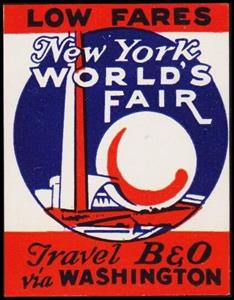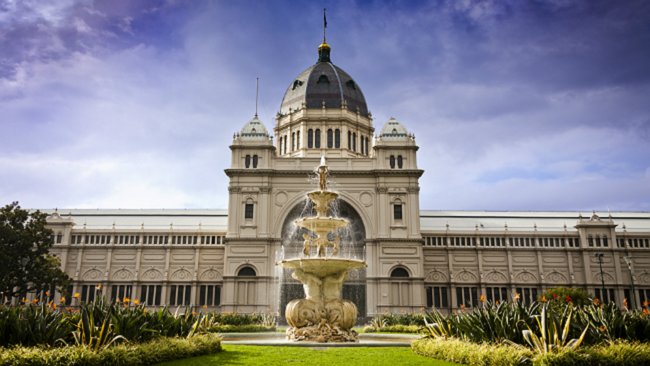Stamp: New york worlds fair low fares travel B and O via (Cinderellas 1939)
New york worlds fair low fares travel B and O via (Cinderellas 1939)
01 January (Cinderellas ) within release U.S.A. goes into circulation Stamp New york worlds fair low fares travel B and O via face value None No Face Value
| Stamp New york worlds fair low fares travel B and O via in catalogues | |
|---|---|
| Colnect codes: | Col: US 1939-24 |
Stamp is square format.
Also in the issue U.S.A.:
- Stamp - National Tuberculosis Association. face value None;
- Stamp - Washington State Golden Juibilee Tacoma face value None;
- Stamp - STATE CAPITAL SERIES poster stamp face value None;
- Stamp - Eaton's Fine Letter Papers face value None;
- Stamp - Denmark At the New York Worlds Fair 1939 face value None;
- Stamp - National Tuberculosis Association. face value None;
- Stamp - National Tuberculosis Association. face value None;
- Stamp - 7th World Poultry congress cleveland ohio face value None;
- Stamp - AFLA Olympic fund amateur fencers face value None;
- Stamp - AFLA Olympic fund amateur fencers face value None;
- Stamp - AFLA Olympic fund amateur fencers face value None;
- Stamp - AFLA. Olympic fund amateur fencers face value None;
- Stamp - Association of south jersey stamp clubs second jamboree face value None;
- Stamp - Chicago antiques exposition and hobby fair face value None;
- Stamp - Chicago international live stock exposition face value None;
- Stamp - Convention headquarters detroit michigan Cadillac Hotel face value None;
- Stamp - Golden gate internat exposition san francisco Pig'nWhistle face value None;
- Stamp - Golden gate international exposition. Pacific pageant face value None;
- Stamp - Gumps invites you to a pageant of the pacific golden gate face value None;
- Stamp - International philatelic week face value None;
- Stamp - Metropolitan oakland area golden gate international expo face value None;
- Stamp - New york worlds fair general electric exhibit buildings face value None;
- Stamp - New york worlds fair low fares travel B and O via face value None;
- Stamp - New york worlds fair see the maze of superstition exhibit. face value None;
- Stamp - New york worlds fair visit the glass center face value None;
- Stamp - New york worlds fair. see swift's premium frankfurts face value None;
- Stamp - Polish pavilion new york worlds fair 1939 face value None;
- Stamp - Visit the ice industry exhibit at the golden gate expo face value None;
- Stamp - Visit the ice industry exhibit at the golden gate expo face value None;
- Stamp - Visit vallejo naval capital and industrial city face value None;
- Stamp - For Victory join the V Club of America. American Ambulance.. face value None;
- Stamp - God bless America face value None;
- Stamp - United Nations Buy war stamps hope of civilization face value None;
|
Data entry completed
46%
|
|
|---|---|
| Stamp New york worlds fair low fares travel B and O via in digits | |
| Country: | Cinderellas |
| Date: | 1939-01-01 |
| Emission: | Cinderella |
| Format: | Stamp |
| Face Value: | None No Face Value |
Stamp New york worlds fair low fares travel B and O via it reflects the thematic directions:
The Royal Exhibition Building is a World Heritage-listed building in Melbourne, Victoria, Australia, built in 1879–1880 as part of the international exhibition movement, which presented over 50 exhibitions between 1851 and 1915 around the globe. The building sits on approximately 26 hectares (64 acres), is 150 metres (490 ft) long and is surrounded by four city streets. It is at 9 Nicholson Street in the Carlton Gardens, flanked by Victoria, Carlton and Rathdowne Streets, at the north-eastern edge of the central business district. It was built to host the Melbourne International Exhibition in 1880–81, and then hosted the even larger Centennial International Exhibition in 1888, and the formal opening of the first Parliament of Australia in 1901. The building is representative of the money and pride Victoria had in the 1870s. Throughout the 20th century smaller sections and wings of the building were subject to demolition and fire; however, the main building, known as the Great Hall, survived.
Tourism is travel for pleasure or business; also the theory and practice of touring, the business of attracting, accommodating, and entertaining tourists, and the business of operating tours. Tourism may be international, or within the traveller's country. The World Tourism Organization defines tourism more generally, in terms which go "beyond the common perception of tourism as being limited to holiday activity only", as people "traveling to and staying in places outside their usual environment for not more than one consecutive year for leisure, business and other purposes". Tourism can be domestic or international, and international tourism has both incoming and outgoing implications on a country's balance of payments. Today, tourism is a major source of income for many countries, and affects the economy of both the source and host countries, in some cases being of vital importance.
A world's fair, also known as a universal exhibition, is a large global exhibition designed to showcase the achievements of nations.These exhibitions vary in character and are held in different parts of the world at a specific site for a period of time, typically between three and six months


